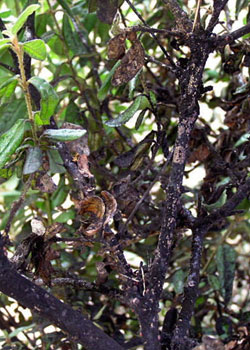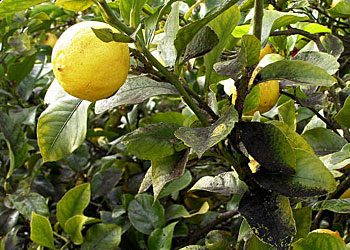
Sooty Mould on Correas and Other Native Plants
Tony Cavanagh
Over the last few years of the drought, we have noticed a marked increase in sooty mould attack on our lemon tree and a number of our native plants. Not many species are affected but those that appear to be susceptible include the correas C. calcina and C. bauerlennii, phebaliums, especially the various forms of P. squamulosum, some of the Philotheca/Eriostemon group, especially, surprisingly, Philotheca myoporoides (the old "Eriostemon myoporoides") and several dodonaeas.
 |
|
Heavy coverage of sooty mould on stems of Correa calycina
Photo: Tony Cavanagh |
|
What is perhaps surprising about this group is that they are all regarded as hardy and reliable garden plants yet I have had infestations so bad on Correa calycina that they have killed the plant. It may well be that these plants are under severe stress with the drought and are have lower resistance to insect attack but there are so many other plants close by that show no affect that I am forced to conclude that some species are simply more susceptible than others. I would be very interested in other people's observations and comments on this problem.
What is sooty mould and how does it affect plants?
The mould itself is black, just like old fashioned soot, and can coat leaves and branches quite thickly if left untreated. At best, it makes plants very unsightly while in severe cases, it can reduce photosynthesis and if sufficiently widespread can lead to plant death.
It is produced by several species of fungi that feed on sugar. The source of the sugar is the "honeydew" excreted by a range of sap sucking insects such as scales, aphids, mealy bugs and lerps. As ants also avidly collect honeydew, they are almost always associated with sooty mould and are probably responsible for spreading the mould through carrying around honeydew. Wherever there is honeydew, there will also be mould. It should be noted that sooty mould is different to the moulds that can form on plants in poorly ventilated or shady situations under humid or drizzle conditions. These arise from a different group of fungi which don't require sugar for example, and can lead to rotting and death of young plants and seedlings. Sooty mould can occur in plants in full sun and a windy situation.
 |
|
Sooty mould on a lemon tree
Photo: Tony Cavanagh |
|
With a bad infestation it can take several treatments to clear up sooty mould. The essential thing is to remove the insects that produce the honeydew, by either spraying or biological means if you have birds and other insects such as ladybirds, hover flies and lacewings.
I have generally sprayed with white oil, using two or even three applications at two weekly intervals - on delicate or young plants, it is advisable to use half or three quarter strength solutions. White oil is especially good on scale insects and mealy bugs but if aphids, lerps, white flies or psyllids are the problem, you may need to use something stronger, such as dimethoate, endosulphan or Confidor. Once the insects are gone, the mould dies and dries out and after a couple of weeks, it can often be washed off with a hose. Plants usually make a full recovery though they still may look ugly with residual mould on branches and leaves.
From the newsletter of ANPSA's Correa Study Group, May 2009.
Australian Plants online - 2009
Australian Native Plants Society (Australia)
|